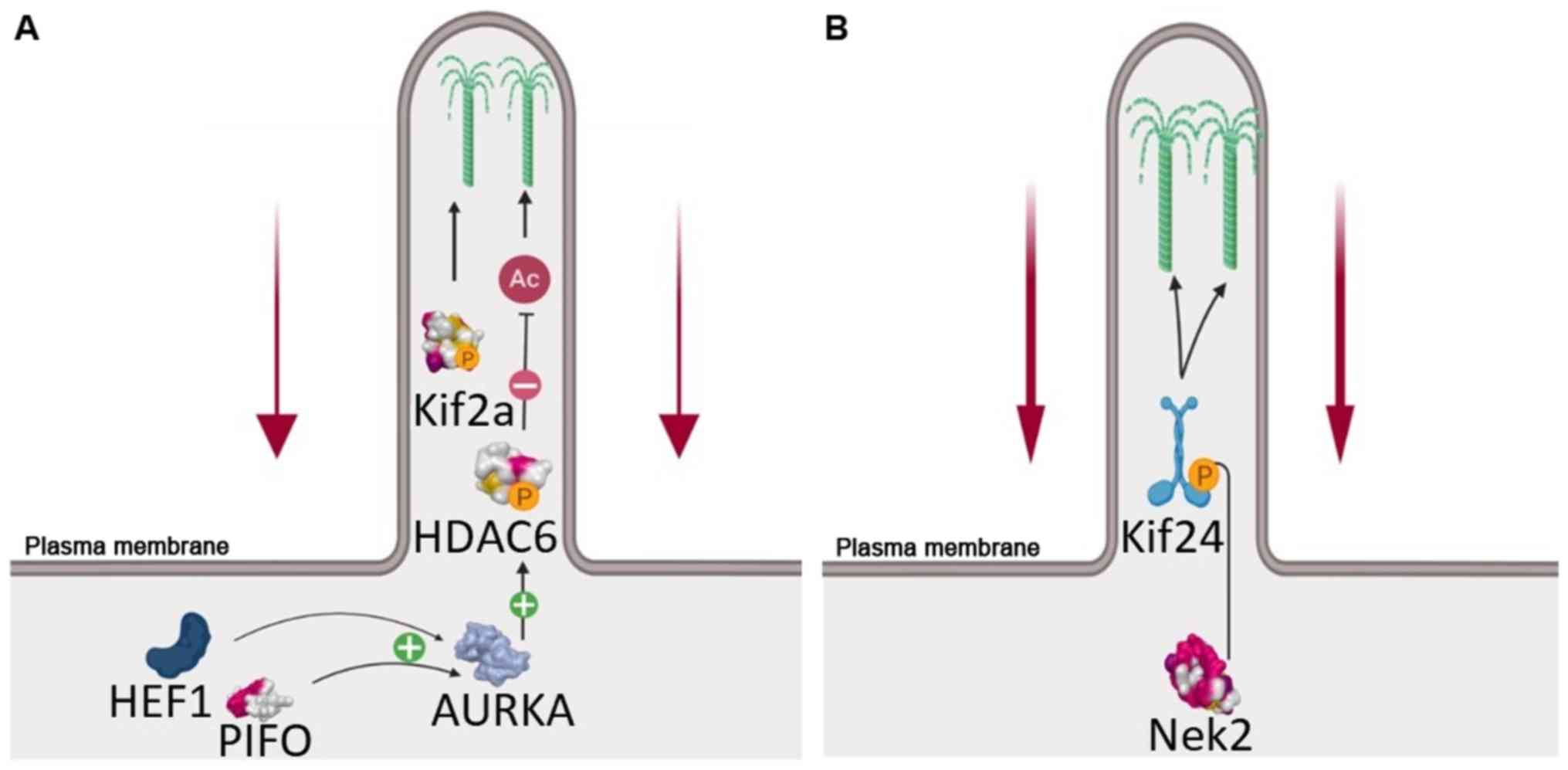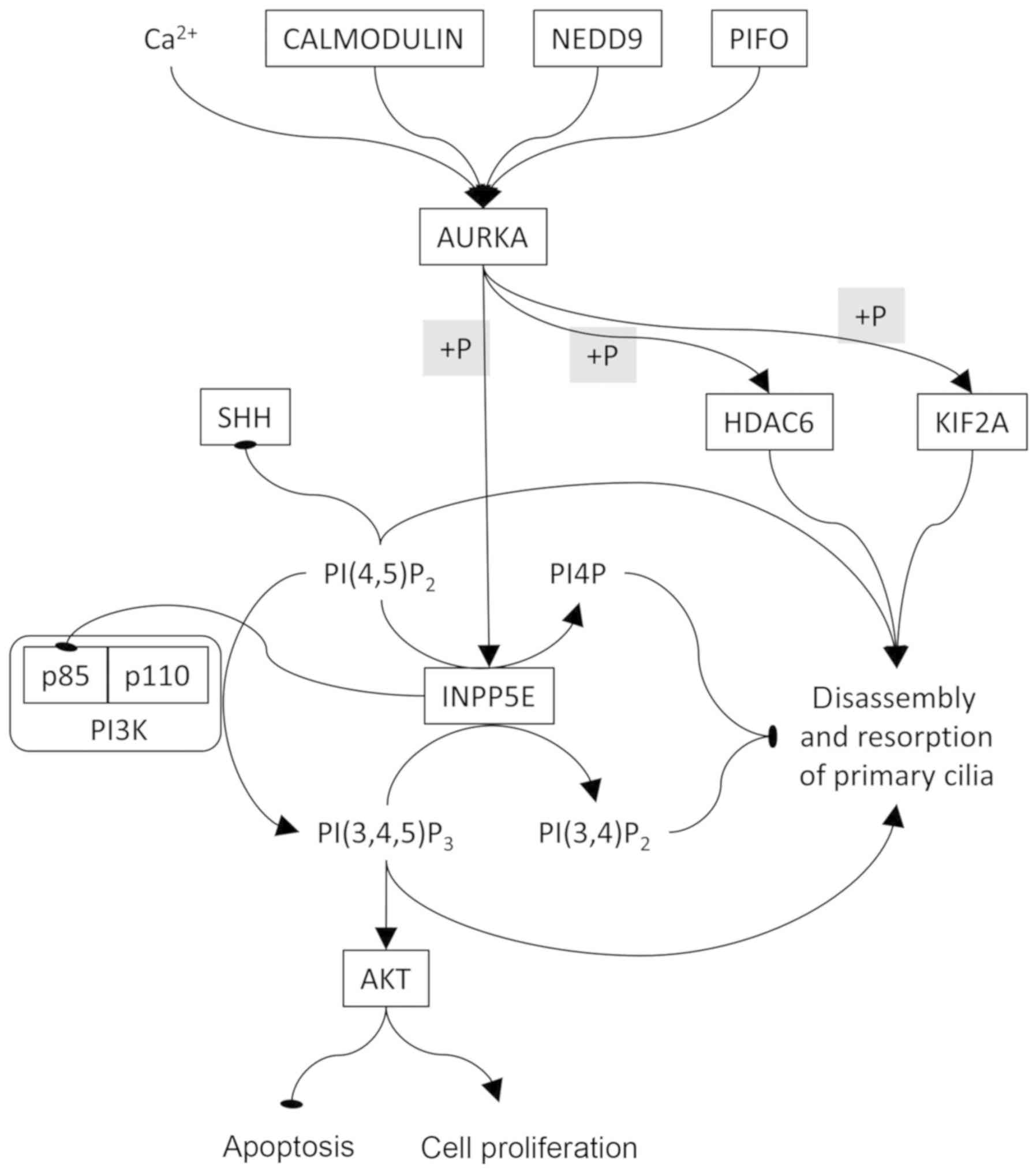|
1
|
Higgins M, Obaidi I and McMorrow T:
Primary cilia and their role in cancer. Oncol Lett. 17:3041–3047.
2019.PubMed/NCBI
|
|
2
|
Pala R, Alomari N and Nauli SM: Primary
Cilium-dependent signaling mechanisms. Int J Mol Sci. 18:22722017.
View Article : Google Scholar :
|
|
3
|
Malicki JJ and Johnson CA: The Cilium:
Cellular antenna and central processing unit. Trends Cell Biol.
27:126–140. 2017. View Article : Google Scholar :
|
|
4
|
Sorokin SP: Reconstructions of centriole
formation and ciliogenesis in mammalian lungs. J Cell Sci.
3:207–230. 1968.PubMed/NCBI
|
|
5
|
Wheway G, Nazlamova L and Hancock JT:
Signaling through the primary cilium. Front Cell Dev Biol. 6:82018.
View Article : Google Scholar : PubMed/NCBI
|
|
6
|
Izawa I, Goto H, Kasahara K and Inagaki M:
Current topics of functional links between primary cilia and cell
cycle. Cilia. 4:122015. View Article : Google Scholar
|
|
7
|
Jonassen JA, San Agustin J, Follit JA and
Pazour GJ: Deletion of IFT20 in the mouse kidney causes
misorientation of the mitotic spindle and cystic kidney disease. J
Cell Biol. 183:377–384. 2008. View Article : Google Scholar : PubMed/NCBI
|
|
8
|
Pugacheva EN, Jablonski SA, Hartman TR,
Henske EP and Golemis EA: HEF1-dependent Aurora A activation
induces disassembly of the primary cilium. Cell. 129:1351–1363.
2007. View Article : Google Scholar : PubMed/NCBI
|
|
9
|
Tucker RW, Pardee AB and Fujiwara K:
Centriole ciliation is related to quiescence and DNA synthesis in
3T3 cells. Cell. 17:527–535. 1979. View Article : Google Scholar : PubMed/NCBI
|
|
10
|
Li A, Saito M, Chuang J, Tseng Y, Dedesma
C, Tomizawa K, Kaitsuka T and Sung C: Ciliary transition zone
activation of phosphorylated Tctex-1 controls ciliary resorption,
S-phase entry and fate of neural progenitors. Nat Cell Biol.
13:402–411. 2011. View
Article : Google Scholar : PubMed/NCBI
|
|
11
|
Breslin L, Prosser SL, Cuffe S and
Morrison CG: Ciliary abnormalities in senescent human fibroblasts
impair proliferative capacity. Cell Cycle. 13:2773–2779. 2014.
View Article : Google Scholar : PubMed/NCBI
|
|
12
|
Spalluto C, Wilson DI and Hearn T: Nek2
localises to the distal portion of the mother centriole/basal body
and is required for timely cilium disassembly at the G2/M
transition. Eur J Cell Biol. 91:675–686. 2012. View Article : Google Scholar : PubMed/NCBI
|
|
13
|
Kim S, Lee K, Choi J, Ringstad N and
Dynlacht BD: Nek2 activation of Kif24 ensures cilium disassembly
during the cell cycle. Nat Commun. 6:80872015. View Article : Google Scholar : PubMed/NCBI
|
|
14
|
Moser JJ, Fritzler MJ and Rattner JB:
Primary ciliogenesis defects are associated with human
astrocytoma/glioblastoma cells. BMC Cancer. 9:4482009. View Article : Google Scholar : PubMed/NCBI
|
|
15
|
Seeley ES, Carrière C, Goetze T,
Longnecker DS and Korc M: Pancreatic cancer and precursor
pancreatic intraepithelial neoplasia lesions are devoid of primary
cilia. Cancer Res. 69:422–430. 2009. View Article : Google Scholar : PubMed/NCBI
|
|
16
|
Gherman A, Davis EE and Katsanis N: The
ciliary proteome database: An integrated community resource for the
genetic and functional dissection of cilia. Nat Genet. 38:961–962.
2006. View Article : Google Scholar : PubMed/NCBI
|
|
17
|
Gradilone SA, Pisarello MJL and LaRusso
NF: Primary cilia in tumor biology: The primary cilium as a
therapeutic target in cholangiocarcinoma. Curr Drug Targets.
18:958–963. 2017. View Article : Google Scholar :
|
|
18
|
Gradilone SA, Radtke BN, Bogert PS, Huang
BQ, Gajdos GB and LaRusso NF: HDAC6 inhibition restores ciliary
expression and decreases tumor growth. Cancer Res. 73:2259–2270.
2013. View Article : Google Scholar : PubMed/NCBI
|
|
19
|
Kim J, Dabiri S and Seeley ES: Primary
cilium depletion typifies cutaneous melanoma in situ and malignant
melanoma. PLoS One. 6:e274102011. View Article : Google Scholar : PubMed/NCBI
|
|
20
|
Hassounah NB, Nagle R, Saboda K, Roe DJ,
Dalkin BL and McDermott KM: Primary cilia are lost in preinvasive
and invasive prostate cancer. PLoS One. 8:e685212013. View Article : Google Scholar : PubMed/NCBI
|
|
21
|
Yuan K, Frolova N, Xie Y, Wang D, Cook L,
Kwon YJ, Steg AD, Serra R and Frost AR: Primary cilia are decreased
in breast cancer: Analysis of a collection of human breast cancer
cell lines and tissues. J Histochem Cytochem. 58:857–870. 2010.
View Article : Google Scholar : PubMed/NCBI
|
|
22
|
Ho L, Ali SA, Al-Jazrawe M, Kandel R,
Wunder JS and Alman BA: Primary cilia attenuate hedgehog signalling
in neoplastic chondrocytes. Oncogene. 32:5388–5396. 2013.
View Article : Google Scholar
|
|
23
|
Egeberg DL, Lethan M, Manguso R, Schneider
L, Awan A, Jprgensen TS, Byskov AG, Pedersen LB and Christensen ST:
Primary cilia and aberrant cell signaling in epithelial ovarian
cancer. Cilia. 1:152012. View Article : Google Scholar
|
|
24
|
Dere R, Perkins AL, Bawa-Khalfe T, Jonasch
D and Walker CL: p-catenin links von Hippel-Lindau to aurora kinase
A and loss of primary cilia in renal cell carcinoma. J Am Soc
Nephrol. 26:553–564. 2015. View Article : Google Scholar
|
|
25
|
Kobayashi T and Itoh H: Loss of a primary
cilium in PDAC. Cell Cycle. 16:817–818. 2017. View Article : Google Scholar : PubMed/NCBI
|
|
26
|
Quilichini E, Fabre M, Dirami T, Stedman
A, De Vas M, Ozguc O, Pasek RC, Cereghini S, Morillon L, Guerra C,
et al: Pancreatic ductal deletion of Hnf1b disrupts exocrine
homeostasis, leads to pancreatitis, and facilitates tumorigenesis.
Cell Mol Gastroenterol Hepatol. 8:487–511. 2019. View Article : Google Scholar : PubMed/NCBI
|
|
27
|
Schimmack S, Kneller S, Dadabaeva N,
Bergmann F, Taylor A, Hackert T, Werner J and Strobel O: Epithelial
to stromal Re-distribution of primary cilia during pancreatic
carcinogenesis. PLoS One. 11:e01642312016. View Article : Google Scholar : PubMed/NCBI
|
|
28
|
Kobayashi T, Nakazono K, Tokuda M, Mashima
Y, Dynlacht BD and Itoh H: HDAC2 promotes loss of primary cilia in
pancreatic ductal adenocarcinoma. EMBO Rep. 18:334–343. 2017.
View Article : Google Scholar :
|
|
29
|
Li D, Zhu J, Firozi PF, Abbruzzese JL,
Evans DB, Cleary K, Friess H and Sen S: Overexpression of oncogenic
STK15/BTAK/Aurora A kinase in human pancreatic cancer. Clin Cancer
Res. 9:991–997. 2003.PubMed/NCBI
|
|
30
|
Plotnikova OV, Nikonova AS, Loskutov YV,
Kozyulina PY, Pugacheva EN and Golemis EA: Calmodulin activation of
Aurora-A kinase (AURKA) is required during ciliary disassembly and
in mitosis. Mol Biol Cell. 23:2658–2670. 2012. View Article : Google Scholar : PubMed/NCBI
|
|
31
|
Plotnikova OV, Seo S, Cottle DL, Conduit
S, Hakim S, Dyson JM, Mitchell CA and Smyth IM: lNPP5E interacts
with aurka, linking phosphoinositide signaling to primary cilium
stability. J Cell Sci. 128:364–372. 2015. View Article : Google Scholar :
|
|
32
|
Garcia-Gonzalo FR, Phua SC, Roberson EC,
Garcia G, Abedin M, Schurmans S, Inoue T and Reiter JF:
Phosphoinositides regulate ciliary protein trafficking to modulate
hedgehog signaling. Dev Cell. 34:400–409. 2015. View Article : Google Scholar : PubMed/NCBI
|
|
33
|
Kisseleva MV, Wilson MP and Majerus PW:
The isolation and characterization of a cDNA encoding
phospholipid-specific inositol polyphosphate 5-phosphatase. J Biol
Chem. 275:20110–20116. 2000. View Article : Google Scholar : PubMed/NCBI
|
|
34
|
Bielas SL, Silhavy JL, Brancati F,
Kisseleva MV, Al-Gazali L, Sztriha L, Bayoumi RA, Zaki MS,
Abdel-Aleem A, Rosti RO, et al: Mutations in INPP5E, encoding
inositol polyphosphate-5-phosphatase E, link phosphatidyl inositol
signaling to the ciliopathies. Nat Genet. 41:1032–1036. 2009.
View Article : Google Scholar : PubMed/NCBI
|
|
35
|
Kisseleva MV, Cao L and Majerus PW:
Phosphoinositide-specific inositol polyphosphate 5-phosphatase IV
inhibits Akt/protein kinase B phosphorylation and leads to
apoptotic cell death. J Biol Chem. 277:6266–6272. 2002. View Article : Google Scholar
|
|
36
|
Phua SC, Chiba S, Suzuki M, Su E, Roberson
EC, Pusapati GV, Schurmans S, Setou M, Rohatgi R, Reiter JF, et al:
Dynamic remodeling of membrane composition drives cell cycle
through primary cilia excision. Cell. 168:264–279.e15. 2017.
View Article : Google Scholar : PubMed/NCBI
|
|
37
|
Mukhopadhyay S, Wen X, Ratti N, Loktev A,
Rangell L, Scales SJ and Jackson PK: The ciliary G-protein-coupled
receptor Gpr161 negatively regulates the sonic hedgehog pathway via
cAMP signaling. Cell. 152:210–223. 2013. View Article : Google Scholar : PubMed/NCBI
|
|
38
|
Chavez M, Ena S, Van Sande J, de Kerchove
d'Exaerde A, Schurmans S and Schiffmann SN: Modulation of ciliary
phosphoinositide content regulates trafficking and sonic hedgehog
signaling output. Dev Cell. 34:338–350. 2015. View Article : Google Scholar : PubMed/NCBI
|
|
39
|
Emoto K, Masugi Y, Yamazaki K, Effendi K,
Tsujikawa H, Tanabe M, Kitagawa Y and Sakamoto M: Presence of
primary cilia in cancer cells correlates with prognosis of
pancreatic ductal adenocarcinoma. Hum Pathol. 45:817–825. 2014.
View Article : Google Scholar : PubMed/NCBI
|
|
40
|
Thayer SP, di Magliano MP, Heiser PW,
Nielsen CM, Roberts DJ, Lauwers GY, Qi YP, Gysin S, Fernandez-del
Castillo C, Yajnik V, et al: Hedgehog is an early and late mediator
of pancreatic cancer tumorigenesis. Nature. 425:851–856. 2003.
View Article : Google Scholar : PubMed/NCBI
|
|
41
|
Bailey J, Mohr A and Hollingsworth M:
Sonic hedgehog paracrine signaling regulates metastasis and
lymphangiogenesis in pancreatic cancer. Oncogene. 28:3513–3525.
2009. View Article : Google Scholar : PubMed/NCBI
|
|
42
|
Deng YZ, Cai Z, Shi S, Jiang H, Shang YR,
Ma N, Wang JJ, Guan DX, Chen TW, Rong YF, et al: Cilia loss
sensitizes cells to transformation by activating the mevalonate
pathway. J Exp Med. 215:177–195. 2018. View Article : Google Scholar :
|
|
43
|
Bangs FK, Miller P and O'Neill E:
Ciliogenesis and Hedgehog signalling are suppressed downstream of
KRAS during Acinar-ductal metaplasia in mouse. Dis Model Mech.
13:dmm0442892020. View Article : Google Scholar : PubMed/NCBI
|
|
44
|
Baretti M, Ahuja N and Azad NS: Targeting
the epigenome of pancreatic cancer for therapy: Challenges and
opportunities. Ann Pancreat Cancer. 2:182019. View Article : Google Scholar
|
















